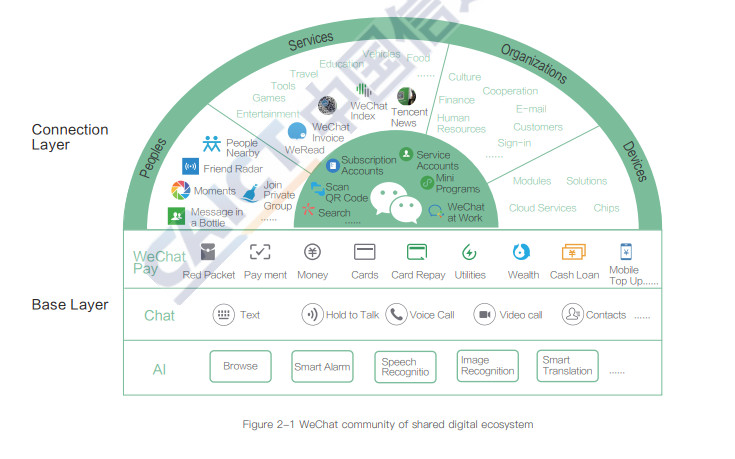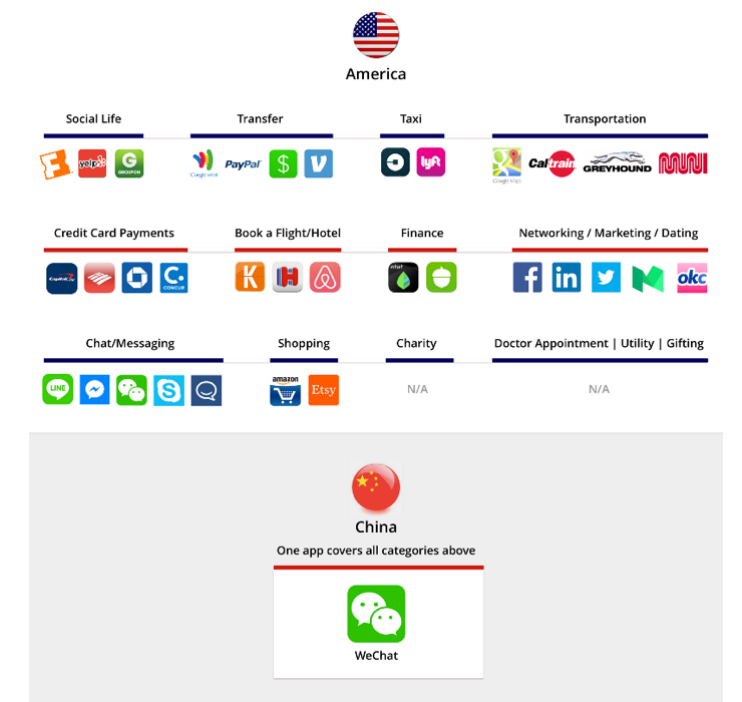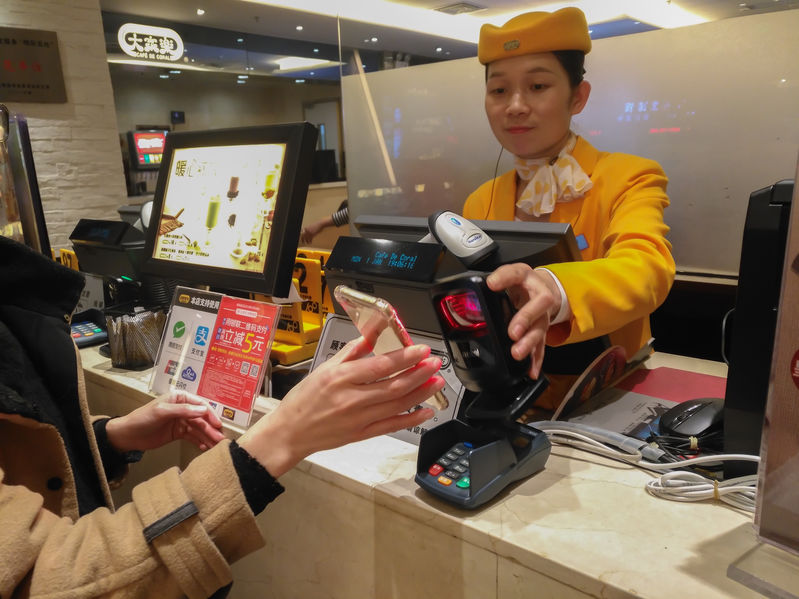With over 1.112 million active monthly users worldwide and 79% diffusion in the country, WeChat is the application that dominates the Chinese market. Due to the wide range of services it integrates, WeChat simplifies the life of Chinese users by uniting apps under the same ecosystem. How do users use WeChat? What opportunities are there for digital marketing on this platform?
How do Chinese users employ WeChat?
In the WeChat Economic and Social Impact report by CAICT (the Chinese Academy for Information and Communication Technologies), the following chart is shown, which visually summarizes what WeChat means to Chinese users:

WeChat is a highly sophisticated app, with an algorithm that uses artificial intelligence for voice and image recognition, and feed customization. It can be employ as an app to:
1. Social media:
- Keep in touch with your contacts and interact with them: on WeChat, users and brands share moments or stories, photos and statuses to which their contacts can react with likes and comments. It also allows the creation of private groups.
- Consume online content: users can read the news, watch videos, follow brands or media pages to keep up to date with publications and they can also become a fan of influencers.
2. Private messaging:
Through WeChat, you can make calls and video calls, send text messages with photos and videos.
3. Apps that offer other services like Mini-Programs:
Mini-Programs work as third-party apps within WeChat. Instead of downloading a different app for each brand, they are integrated within WeChat and offer services for over 200 sectors. Some examples are the mini-games, but there are also Mini-Programs for travel reservations, e-commerce, home-delivered meals and more.
A European uses at least ten different apps a day, each specialized in a particular task (different social networks, messaging, video watching, payments, etc.). Chinese users do not need to jump from one application to another: they access all these services via WeChat.
Tony Cheung, Managing Director at Labelium China
4. Business communication using ‘WeChat at Work’:
According to China Internet Watch, 80% of China’s top 500 companies use WeChat daily to manage their communications with both their employees and customers. WeChat at Work allows you to organize tasks, manage employee time and even make calls in the context of work.
5. Payment method or wallet:
The WeChat Pay service allows its users to link their bank account to the app, so they pay with it using their credit cards and complete other financial functions such as direct purchases, deposits and transfers to other accounts, as well as loan requests.
The importance of QR codes here should be highlighted. Companies that offer payments via WeChat Pay must get used to working with this type of code, given that the usual practice is for users to scan the codes and receive the product page on their smartphone to complete the payment with the phone.

Opportunities for digital marketing on WeChat
How can brands harness the potential of WeChat beyond their presence in organic content?
Types of accounts on WeChat:
It is worth reviewing the different types of accounts that WeChat allows you to open on its platform:
- Subscription account: they are focused on the creation and dissemination of content that users can share and interact with. The owner can be an individual user or a company. It has one push post per day available and the menu bars can be customized, but it does not have integrated payment methods. The revenue stream is achieved through display ad placements.
- Service account: they are intended for companies, as they maximize the reach of their publications. They allow four push publications per month, which the user receives through a chat message. They do have the possibility of developing payment methods for e-commerce, coupons and loyalty programs.
- Business account: it is required to operate with WeChat at Work. It is an internal company tool, therefore, there are no limits for push messages.
WeChat advertising formats:
There are different formats to reach the user through WeChat advertising:
- Banner ads: this type of ad appears on articles published on the platform. They can include creativities that highlight the brand, but also the much-used QR codes as a way to promote coupons or special discounts.
- Key Opinion Leaders (KOL) publications: they are the influencers in the world of WeChat. As in Western social networks, the brand must agree with KOL to publish one of their images.
- Advertising with moments: this type of ads are similar to those shown on the Facebook feed, although on WeChat they are placed in the “moments” section of the platform. They show the logo, a description and images or videos with a CTA that directs users to the destination page (usually HTML5 pages hosted on Tencent’s servers). They disappear after 6 hours if they do not make any impact, therefore, the more interaction they have, the longer they will last online.
- Ads on Mini-Programs: videos can be advertised on these applications in the middle of the Mini-Program or before using it. The application developer can decide where the ad will be placed.

Segmentations available on WeChat for advertising campaigns:
The objective of WeChat is to concentrate all user traffic on one platform. In fact, the possibility of including external links has recently been dropped as highlighted by China Internet Watch. Therefore, the options to segment and refine the audiences to which the advertising is directed are very broad. These are the main ones:
- According to data on their profile: it includes traditional demographic segmentation by sex, age, marital status, education, work and location. As for the latter, WeChat classifies the areas with Beijing, Shanghai and then groups in two ranges the rest of the cities and areas according to their population. Advertising can also be directed to users in 42 countries and regions abroad.
- Interests: on WeChat you can select interests belonging to different sectors (education, travel, fashion, food and finance, among others), but it is also possible to include specific keywords to segment audiences.
- Behavior: it covers the use of Mini-Programs. You can select applications by category or specifically those that the user has installed.
- Consumption capacity: it includes the use of Mini-Programs. One can select applications by category or specifically those that the user has installed.
- Device type: it can be segmented by phone brand or connection type (e.g. wifi, 4G or even 5G networks, which in some areas of China are already operating).
- WeChat usage characteristics: this type of segmentation refers to each user’s type of traffic on WeChat, i.e. which accounts they follow, which pages they visit and the type of content they consume. As a result, it is possible to detect where they are in the Customer Journey.
- Weather: with the location information it is possible to adjust the campaigns to the weather of each region. With an extensive and varied geography, this is a crucial segmentation for some sectors such as fashion.
The possibilities offered by WeChat to reach Chinese consumers are of great interest to brands, whether they are thinking of internationalizing their business or reaching the many Chinese expatriates living in the West.







